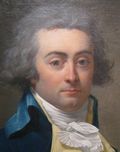 |
Marie-Jean Hérault de Séchelles
b. 20 Oct 1759, Paris
d. 5 Apr 1794, Paris |
| Title: |
Président de la Convention nationale (President of the National Convention) |
| Term: |
1 Nov 1792 - 15 Nov 1792 |
| Chronology: |
1 Nov 1792,
elected, assumed the chair immediately upon the proclamation of election, session of the Convention, Salle du Manège, Paris [1] |
|
15 Nov 1792,
ceased to exercise the functions of office upon the election of a successor [2] |
| Term: |
8 Aug 1793 - 22 Aug 1793 |
| Chronology: |
8 Aug 1793,
elected, session of the National Convention, salle des Machines, Palais national des Tuileries, Paris [3] |
|
9 Aug 1793,
assumed the chair, session of the National Convention, salle des Machines, Palais national des Tuileries, Paris [3] |
|
22 Aug 1793,
ceased to exercise the functions of office upon the election of a successor [4] |
| Other offices: |
Président de l'Assemblée nationale (President of the National Assembly) (2 Sep 1792 - 16 Sep 1792) [see details] |
| Biography: |
| Son of a military officer and grandson of lieutenant-general of the Paris police; studied law and was admitted to the bar at the Châtelet, the seat of common-law jurisdiction (1777); was introduced to Queen Marie-Antoinette, spouse of King Louis XVI, whose protection helped him to be named (1785) attorney general of the Parlement of Paris; elected (16 Sep 1791) as a representative of Paris to the Assemblée nationale (National Assembly) (1791-1792); joined the faction of radical left deputies; served as Vice President (20 Aug 1792 - 2 Sep 1792) and President (2 Sep 1792 - 16 Sep 1792) of the National Assembly; was appointed a member of the Commission extraordinaire des Douze (Extraordinary Commission of Twelve) (13 Aug 1792 - 21 Sep 1792); elected to the Convention nationale (National Convention) (1792-1794) by two départements, opted for Seine-et-Oise; sat with the Montagnards; served two terms as President of the National Convention (4 Oct 1792 - 18 Oct 1792, 8 Aug 1793 - 22 Aug 1793); was elected a member of the Comité de sûreté générale (Committee of General Security) (17 Oct 1792 - 9 Jan 1793); sent on missions to Alsace and Haute-Savoie (1792-1793); was absent during the trial of Louis XVI, but supported the condemnation of the king; elected a member of the Comité de salut public (Committee of Public Safety) (30 May 1793 - 29 Dec 1793); presided over the Feast of Unity and Indivisibility and solemn acceptance of the Constitution in Paris (10 Aug 1793); served as representative of the Convention to the département of Haut-Rhin (26 Oct 1793 - 11 Dec 1793); was one of the authors of the Constitution of 1793; accused of plotting with royalists, submitted resignation as a member of the Committee of Public Safety (29 Dec 1793) to the National Convention; arrested (15 Mar 1794) and sentenced to death (5 Apr 1794) along with Georges Danton, Jean-François Delacroix, Camille Desmoulins and others.
|
| Biographical sources: Dictionnaire des Conventionnels, 330-333;
Dictionnaire des parlementaires français 1789-1889, 3:339-341. |
| Elections: |
| Candidate |
Votes (1 Nov 1792) |
| Marie-Jean Hérault de Séchelles |
absolute majority (2nd ballot) |
| Jean-Paul Rabaut, dit Rabaut Saint-Etienne |
n/a |
| Candidate |
Votes (8 Aug 1793) |
| Marie-Jean Hérault de Séchelles |
165 |
| voters |
236 |
|
| Source of electoral results: Archives parlementaires - Série 1, 53:108;
Archives parlementaires - Série 1, 70:531.
|
| |
| [1] |
Archives parlementaires - Série 1, 53:108. |
| [2] |
Archives parlementaires - Série 1, 53:429;
Procès-verbal de la Convention nationale, 3:190. |
| [3] |
Archives parlementaires - Série 1, 70:531. |
| [4] |
Archives parlementaires - Série 1, 72:638;
Procès-verbal de la Convention nationale, 19:160. |
|
Image: portrait by Jean-Louis Laneuville. |

